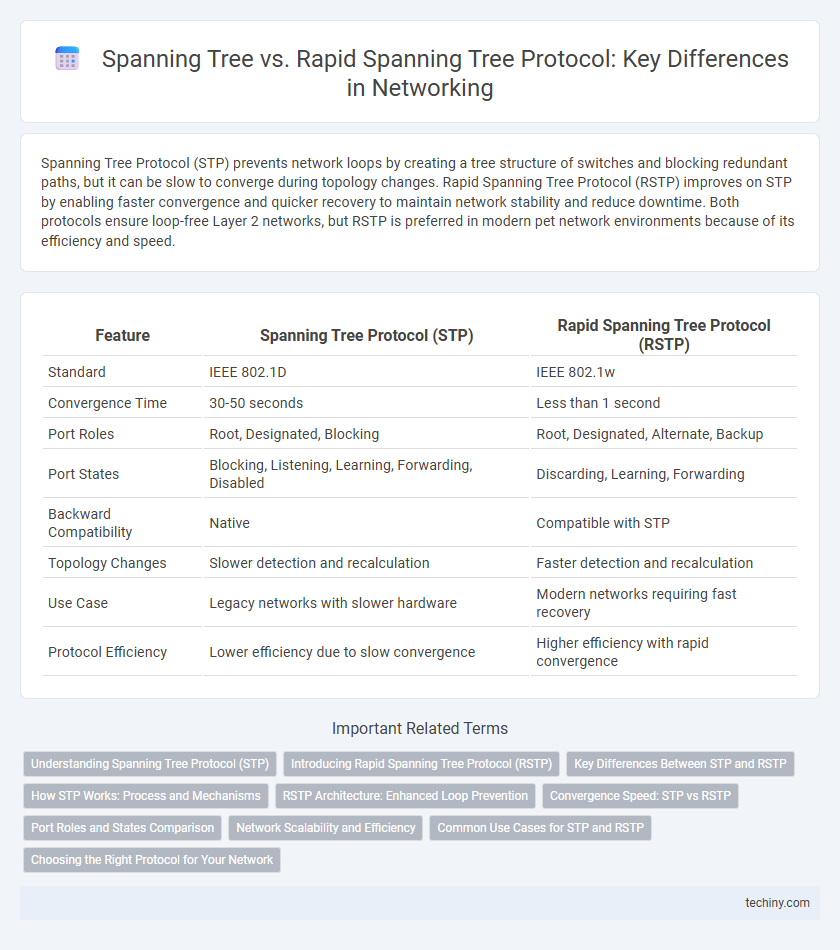Spanning Tree Protocol (STP) prevents network loops by creating a tree structure of switches and blocking redundant paths, but it can be slow to converge during topology changes. Rapid Spanning Tree Protocol (RSTP) improves on STP by enabling faster convergence and quicker recovery to maintain network stability and reduce downtime. Both protocols ensure loop-free Layer 2 networks, but RSTP is preferred in modern pet network environments because of its efficiency and speed.
Table of Comparison
| Feature | Spanning Tree Protocol (STP) | Rapid Spanning Tree Protocol (RSTP) |
|---|---|---|
| Standard | IEEE 802.1D | IEEE 802.1w |
| Convergence Time | 30-50 seconds | Less than 1 second |
| Port Roles | Root, Designated, Blocking | Root, Designated, Alternate, Backup |
| Port States | Blocking, Listening, Learning, Forwarding, Disabled | Discarding, Learning, Forwarding |
| Backward Compatibility | Native | Compatible with STP |
| Topology Changes | Slower detection and recalculation | Faster detection and recalculation |
| Use Case | Legacy networks with slower hardware | Modern networks requiring fast recovery |
| Protocol Efficiency | Lower efficiency due to slow convergence | Higher efficiency with rapid convergence |
Understanding Spanning Tree Protocol (STP)
Spanning Tree Protocol (STP) prevents network loops by creating a loop-free topology in Ethernet networks, selecting a root bridge, and blocking redundant paths. Rapid Spanning Tree Protocol (RSTP) enhances STP by providing faster convergence and improved network stability through rapid transition states and efficient port roles. Understanding STP is crucial for network engineers to design resilient, loop-free Layer 2 networks while minimizing downtime during topology changes.
Introducing Rapid Spanning Tree Protocol (RSTP)
Rapid Spanning Tree Protocol (RSTP), defined by IEEE 802.1w, enhances traditional Spanning Tree Protocol by significantly reducing network convergence time after topology changes from 30-50 seconds to typically under 1 second. RSTP introduces new port roles and states, such as edge ports and alternate ports, to quickly reconfigure the network and prevent bridging loops. This improvement ensures faster recovery and greater network stability in complex Ethernet LAN environments.
Key Differences Between STP and RSTP
Spanning Tree Protocol (STP) and Rapid Spanning Tree Protocol (RSTP) differ primarily in convergence speed, with RSTP offering significantly faster recovery from network changes, typically within a few seconds, compared to STP's 30 to 50 seconds. RSTP introduces enhanced port roles such as alternate and backup ports, which improve fault tolerance and reduce topology change times. While STP uses a slower handshaking process to determine port states, RSTP employs a more efficient point-to-point link detection mechanism, enabling rapid transition of ports to the forwarding state.
How STP Works: Process and Mechanisms
Spanning Tree Protocol (STP) operates by electing a root bridge and blocking redundant paths to prevent network loops, using BPDU (Bridge Protocol Data Units) exchange to maintain a loop-free topology. The protocol involves a listening phase to detect topology changes, followed by the learning phase where MAC addresses are populated, before forwarding frames, ensuring a stable network. Rapid Spanning Tree Protocol (RSTP) enhances this process by introducing faster convergence through immediate transitions to forwarding state for designated ports, and synchronization for rapid network recovery.
RSTP Architecture: Enhanced Loop Prevention
Rapid Spanning Tree Protocol (RSTP) enhances traditional Spanning Tree Protocol by significantly reducing convergence time to seconds, leveraging its superior port roles such as Root, Designated, Alternate, and Backup for efficient network topology management. RSTP's architecture introduces proposal and agreement handshakes, enabling rapid transition of ports to forwarding state, which prevents loops more effectively compared to STP's listening and learning states. This proactive loop prevention mechanism in RSTP minimizes network downtime and improves overall resilience in Ethernet bridged networks.
Convergence Speed: STP vs RSTP
Spanning Tree Protocol (STP) typically converges within 30 to 50 seconds after a topology change, causing noticeable network downtime. Rapid Spanning Tree Protocol (RSTP) dramatically improves convergence speed, reducing it to as low as a few seconds by using enhanced port roles and rapid state transitions. This faster convergence in RSTP minimizes network outages and enhances overall network resilience.
Port Roles and States Comparison
Spanning Tree Protocol (STP) ports assume roles such as Root, Designated, and Blocking, transitioning through states including Blocking, Listening, Learning, and Forwarding to prevent network loops. Rapid Spanning Tree Protocol (RSTP) enhances convergence by introducing roles like Alternate and Backup, while streamlining port states to Discarding, Learning, and Forwarding for faster topology changes. RSTP's refined port roles and reduced state transitions enable improved link recovery times compared to traditional STP.
Network Scalability and Efficiency
Rapid Spanning Tree Protocol (RSTP) significantly enhances network scalability and efficiency compared to the traditional Spanning Tree Protocol (STP) by reducing convergence time from 30-50 seconds to a few milliseconds. RSTP improves network performance in large, complex topologies by swiftly recalculating active paths during link failures, minimizing downtime and packet loss. Overall, RSTP supports high-density network environments with faster topology changes and better resource utilization, making it ideal for scalable, efficient Ethernet networks.
Common Use Cases for STP and RSTP
Spanning Tree Protocol (STP) is commonly deployed in traditional Layer 2 networks to prevent broadcast storms and ensure loop-free topologies, especially in legacy enterprise environments with redundant links. Rapid Spanning Tree Protocol (RSTP) is favored in modern, high-availability networks requiring faster convergence times, such as data centers and large campus networks with frequent topology changes. Both protocols maintain network stability, but RSTP significantly reduces downtime by rapidly transitioning ports to forwarding states during topology changes.
Choosing the Right Protocol for Your Network
Choosing between Spanning Tree Protocol (STP) and Rapid Spanning Tree Protocol (RSTP) depends largely on network size and performance requirements. RSTP offers significantly faster convergence times, reducing downtime during topology changes, which is crucial for modern, high-availability networks. While STP provides basic loop prevention, RSTP's enhancements ensure quicker recovery and improved network stability in dynamic environments.
Spanning Tree vs Rapid Spanning Tree Infographic

 techiny.com
techiny.com